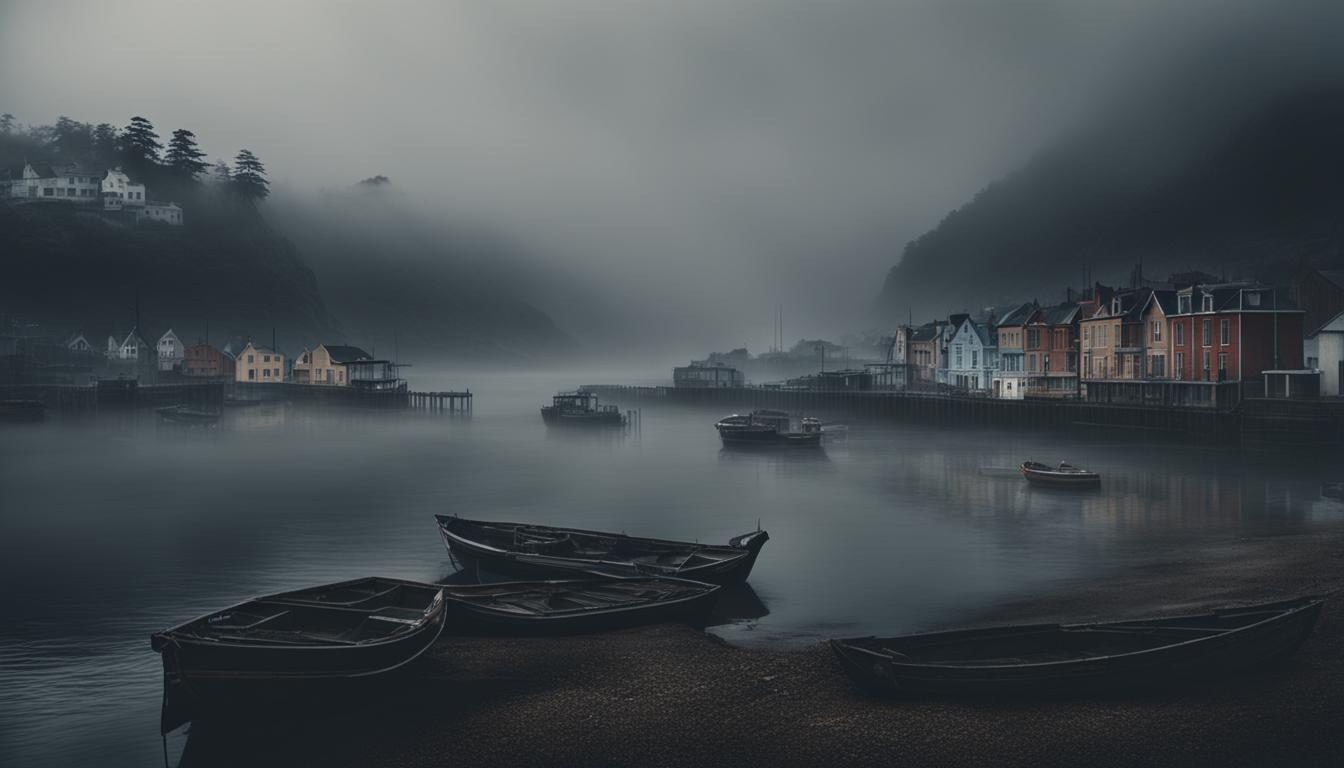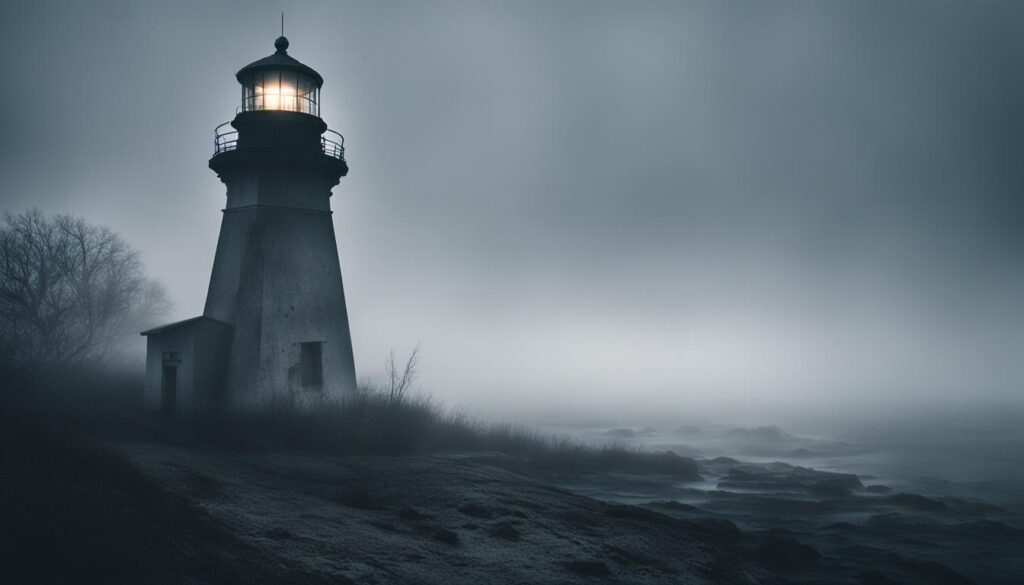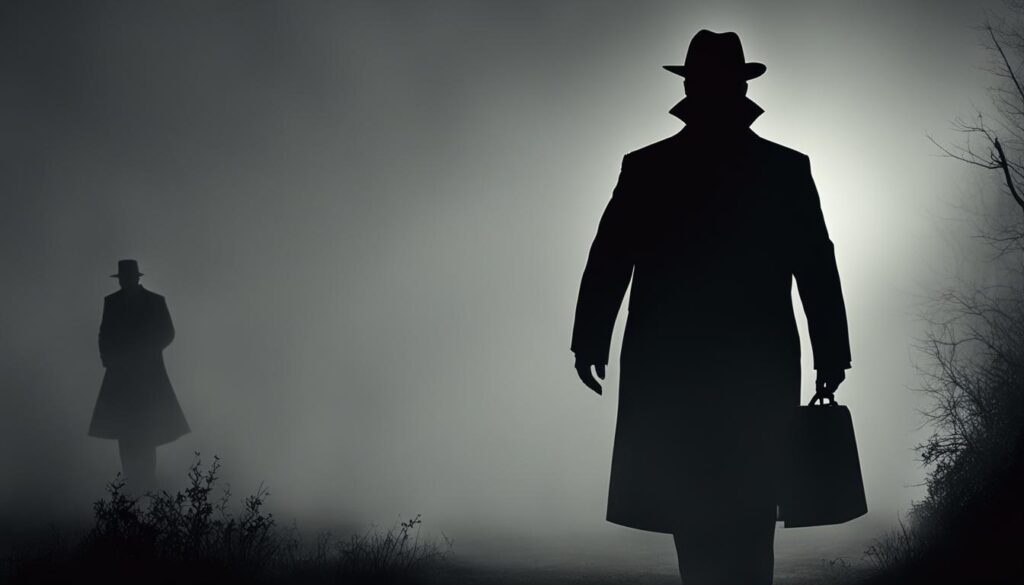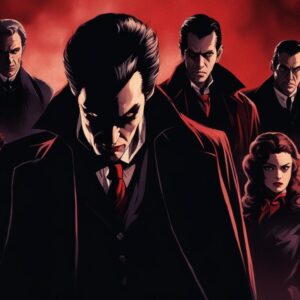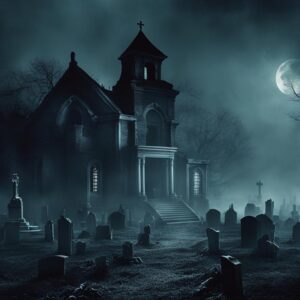As a lover of vintage horror classics, I could not resist diving into the chilling mysteries and cinematic genius of The Fog (1980). Directed by the legendary John Carpenter, this film takes us on a haunting journey to a small coastal town haunted by vengeful ghosts emerging from a mysterious fog. Join me as I explore the atmospheric storytelling, memorable performances, and enduring appeal of this timeless horror masterpiece.
Key Takeaways:
- The Fog (1980) is a vintage horror classic directed by John Carpenter.
- The plot revolves around a small coastal town haunted by vengeful ghosts emerging from a mysterious fog.
- The film’s eerie atmosphere and setting enhance the chilling tone and suspenseful atmosphere.
- The talented ensemble cast delivers convincing performances, adding depth and emotion to the story.
- John Carpenter’s filmmaking and cinematic techniques contribute to the overall impact of the film.
The Plot of The Fog (1980)
The plot of The Fog (1980) centers around the residents of Antonio Bay, a secluded Pacific coastal town, who begin to experience strange occurrences on the 100th anniversary of the town’s founding. These occurrences include gas pumps falling, car alarms sounding, and a glowing fog rolling in from the ocean. As the fog engulfs the town, the residents are faced with ghostly revenge from the past, leading to a suspenseful and eerie atmosphere throughout the film.
The story unfolds as the townspeople slowly uncover the dark secret behind the haunting manifestations. It is revealed that the fog carries the spirits of a group of sailors who were betrayed and killed by Antonio Bay’s founding fathers. Seeking revenge, the vengeful ghosts target the descendants of those responsible, their presence becoming increasingly malevolent as the night progresses.
The main protagonist, Stevie Wayne (played by Adrienne Barbeau), is a radio DJ who narrates the film and provides a sense of tension and urgency. As the fog intensifies and the ghostly entities close in on the town, Stevie and a group of survivors must unravel the mystery and find a way to stop the vengeful spirits before they claim more innocent lives.
Throughout the film, the plot of The Fog (1980) delivers a gripping and suspenseful narrative, blending supernatural elements with classic horror themes. As the residents of Antonio Bay face the terrifying consequences of their ancestors’ actions, the audience is taken on a thrilling journey filled with scares, mystery, and unexpected twists. The combination of the eerie atmosphere, the chilling presence of the fog, and the haunting revenge of the ghostly sailors makes The Fog (1980) a timeless classic in the horror genre.
The Atmosphere and Setting of The Fog (1980)
The atmosphere and setting of The Fog (1980) play a crucial role in creating the chilling and suspenseful tone of the film. The coastal town of Antonio Bay is depicted as a small-town legend, with its dark past and haunted ship lurking in the fog. The eerie atmosphere is enhanced by the supernatural elements, including the ghostly fog and the haunting visuals of the ocean and lighthouse.
As the fog rolls in, it becomes a character in itself, shrouding the town in darkness and obscuring the vision of its residents. The dense fog creates a sense of claustrophobia and isolation, trapping the characters within their own fears and uncertainties. The setting of Antonio Bay, with its empty streets and abandoned buildings, adds to the feeling of desolation and impending doom.
“The fog is a presence throughout the film, constantly lurking in the background and creating an atmosphere of unease and foreboding. It envelops the town, hiding the vengeful spirits and intensifying the sense of danger and impending doom.”
The visual depiction of the fog and the town’s surroundings is masterfully done, with John Carpenter utilizing lighting techniques and cinematography to create a haunting and atmospheric experience for the audience. The use of shadows, silhouettes, and dimly lit interiors adds to the sense of mystery and terror. Combined with the eerie sound design and a haunting musical score, the atmosphere and setting of The Fog (1980) immerse viewers in a world where the supernatural and the ordinary collide.
| Key Elements of the Atmosphere and Setting | Description |
|---|---|
| Ghostly Fog | The fog serves as a recurring symbol throughout the film, representing the vengeful spirits and their connection to the town’s dark past. |
| Coastal Town of Antonio Bay | The town’s isolated location and haunting history contribute to the eerie atmosphere, portraying it as a character in its own right. |
| Ocean and Lighthouse | The ocean and lighthouse are visually stunning and add to the supernatural ambiance, creating a sense of mystery and danger. |
| Dimly Lit Interiors | The use of lighting techniques and shadows enhance the suspenseful atmosphere, keeping the audience on edge. |
The Characters and Performances in The Fog (1980)
The Fog (1980) boasts a talented ensemble cast, each delivering convincing performances that add depth and emotion to the story. Adrienne Barbeau stands out as Stevie Wayne, the radio DJ who narrates the film and provides a sense of tension and urgency. Barbeau’s portrayal captures the fear and terror Stevie experiences as the supernatural events unfold. Jamie Lee Curtis, known for her roles in other horror classics such as Halloween, delivers a strong performance as Elizabeth Solley, a hitchhiker who becomes entangled in the ghostly revenge plaguing Antonio Bay. Tom Atkins brings charisma and gravitas to the role of Nick Castle, a local resident who becomes determined to unravel the mysteries of the fog. Janet Leigh, a veteran actress known for her role in Psycho, makes a memorable appearance as Kathy Williams, a town resident who becomes a target of the vengeful spirits. The chemistry among the cast members enhances the believability of the characters and their plight, making the audience invested in their fate.
Table:
| Character | Actor |
|---|---|
| Stevie Wayne | Adrienne Barbeau |
| Elizabeth Solley | Jamie Lee Curtis |
| Nick Castle | Tom Atkins |
| Kathy Williams | Janet Leigh |
“The Fog (1980) boasts a talented ensemble cast, each delivering convincing performances that add depth and emotion to the story.”
The performances in The Fog (1980) elevate the film beyond a typical horror movie, allowing the audience to connect with the characters and their struggle against the vengeful spirits. The cast’s ability to convey genuine fear and terror enhances the suspense and tension throughout the film. Their performances serve as a testament to the talent and dedication of the actors involved, solidifying The Fog (1980) as a standout entry in the horror genre.
The Filmmaking and Cinematic Techniques in The Fog (1980)
The Fog (1980) is a testament to John Carpenter’s mastery of filmmaking and his skillful use of cinematic techniques. From the opening scenes to the climactic moments, Carpenter’s direction and visual storytelling elevate the horror classic to new heights of suspense and terror.
One of the key elements of Carpenter’s filmmaking style in The Fog (1980) is his use of atmospheric lighting to create a sense of dread and foreboding. The film is bathed in ominous shadows and eerie hues, enhancing the supernatural elements and adding to the overall mood of the story. Carpenter also utilizes clever camera angles and framing to maximize tension, drawing the viewer into the haunted world of Antonio Bay.
In addition to lighting and camera work, Carpenter employs effective editing techniques to build suspense and heighten the scares. He skillfully cuts between different locations and characters, creating a sense of urgency and anticipation. The pacing of the film is carefully crafted, allowing moments of quiet tension to build before unleashing moments of intense horror. These editing choices, combined with Carpenter’s use of atmospheric sound design, create a truly immersive and chilling experience for the audience.
Another notable aspect of the filmmaking in The Fog (1980) is the attention to detail in the production design. The fog itself becomes a character in the film, with Carpenter and his team meticulously crafting the physical effects to give it an ethereal and otherworldly quality. The practical effects, including the use of miniatures and models, add a tangible and visceral quality to the supernatural elements in the film.
Overall, John Carpenter’s filmmaking and use of cinematic techniques in The Fog (1980) enhance the storytelling and elevate the horror classic to iconic status. The atmospheric lighting, clever editing, and meticulous production design all contribute to the eerie and suspenseful nature of the film. It is a prime example of Carpenter’s skill and creativity as a filmmaker and solidifies The Fog as a standout entry in the horror genre.
The Legacy and Influence of The Fog (1980)
The Fog (1980) has left a lasting legacy in the horror genre. It has become a cult classic, cherished by fans for its atmospheric storytelling and well-executed scares. The film’s success paved the way for John Carpenter’s future works and solidified his reputation as a master of horror. Additionally, The Fog (1980) has had a significant influence on subsequent horror films, inspiring filmmakers with its blend of suspense, supernatural elements, and classic storytelling techniques.
The legacy of The Fog (1980) can be seen in the numerous homages and references made to the film in popular culture. Its iconic imagery, such as the ghostly fog rolling in from the sea and the haunting presence of vengeful spirits, has become ingrained in the collective consciousness of horror enthusiasts. The film’s atmospheric storytelling and suspenseful plot have set a precedent for future horror films, influencing the way filmmakers approach building tension and creating a sense of dread.
Furthermore, The Fog (1980) introduced audiences to the concept of a supernatural force seeking revenge for past sins, a theme that has since become a staple in the horror genre. The film’s exploration of guilt, redemption, and the power of storytelling resonates with viewers on a deeper level, provoking thought and discussion long after the credits roll. The enduring appeal of The Fog (1980) lies in its ability to captivate audiences with its timeless scares and chilling atmosphere, ensuring its place in horror history.
| Legacy | Influence |
|---|---|
| Has become a cult classic | Inspired subsequent horror films |
| Elevated John Carpenter’s reputation as a master of horror | Influenced atmospheric storytelling and suspenseful plot-building |
| Iconic imagery ingrained in popular culture | Introduced the concept of supernatural revenge |
| Explores themes of guilt, redemption, and the power of storytelling | Resonates with viewers on a deeper level |
| Enduring appeal due to timeless scares and chilling atmosphere | Ensures its place in horror history |
The Reception and Critical Response to The Fog (1980)
Upon its release, The Fog (1980) received generally favorable reception from audiences and critics alike. While it did not achieve the same commercial success as John Carpenter’s previous film Halloween, it garnered positive reviews for its atmospheric storytelling, effective scares, and strong performances.
The film’s ability to create a sense of dread and suspense was praised by critics, who noted the skillful blending of supernatural elements with classic horror themes. The eerie atmosphere and haunting visuals contributed to the overall impact of the film, leaving audiences captivated and on the edge of their seats.
“The Fog envelops you in a chilling embrace, weaving a tale of revenge and redemption that lingers long after the credits roll.” – Horror Magazine
Over the years, The Fog (1980) has gained a dedicated fanbase and has been recognized as a standout entry in John Carpenter’s filmography. Its enduring appeal lies in its timeless scares and its ability to create a lasting impact on viewers, cementing its status as a vintage horror classic.
| Publication | Review Quote |
|---|---|
| Horror Magazine | “The Fog envelops you in a chilling embrace, weaving a tale of revenge and redemption that lingers long after the credits roll.” |
| Movie Review Digest | “A masterclass in atmospheric storytelling, The Fog leaves a haunting impression that is hard to shake.” |
| Entertainment Weekly | “The Fog showcases Carpenter’s talent for building tension and delivering genuine scares, solidifying its status as a vintage horror classic.” |
The Remake of The Fog (2005)
In 2005, a remake of The Fog was released with the aim of reintroducing the classic story to a new generation. While the remake attempted to capture the essence of the original, it received mixed reviews from both critics and fans. Many felt that the remake failed to capture the atmospheric tension and suspense of the original, and the changes made to the storyline were deemed unnecessary.
Despite an enthusiastic cast and modern updates in visual effects, the remake did not achieve the same level of success or critical acclaim as the original. It struggled to recapture the eerie atmosphere and captivating storytelling that made the 1980 version a vintage horror classic.
“The 2005 remake of The Fog lacks the chilling suspense and atmospheric brilliance of the original. It falls short in capturing the essence that made the first film such a standout in the horror genre.” – Film Critic
While the remake may have introduced The Fog to a new audience, it failed to live up to the legacy of its predecessor. Fans of the original continue to appreciate the vintage horror classic for its timeless scares and chilling atmosphere, making it a difficult act to follow.
| Aspect | The Fog (1980) | The Fog (2005) |
|---|---|---|
| Atmosphere | Eerie and suspenseful | Less atmospheric |
| Storyline | Captivating and well-executed | Changes deemed unnecessary |
| Reception | Positive reviews and dedicated fanbase | Mixed reviews from critics and fans |
| Legacy | Cult classic and influential | Less impact and recognition |
The Restoration and Re-release of The Fog (1980)
The Fog (1980) underwent a restoration process and was re-released on 4K by Scream Factory in 2022. The restoration aimed to enhance the visual and audio quality of the film, allowing audiences to experience the cinematic brilliance of The Fog in high definition. The re-release includes a variety of special features, making it a must-have for fans of the vintage horror classic.
The restoration of The Fog (1980) brings new life to the film, preserving its atmospheric storytelling and iconic visuals for modern audiences. The enhanced visual and audio quality allows viewers to immerse themselves in the eerie atmosphere of Antonio Bay and feel the full impact of the supernatural elements. The 4K restoration brings out the intricate details of the cinematography, showcasing the rich colors and textures that contribute to the film’s haunting ambiance.
“The restoration of The Fog (1980) breathes new life into this vintage horror classic, capturing the essence of John Carpenter’s atmospheric storytelling and allowing audiences to experience the film in all its glory.”
The re-release of The Fog (1980) also includes a range of special features that provide deeper insights into the making of the film. These features may include interviews with cast and crew members, behind-the-scenes footage, and commentary tracks that offer valuable perspectives on the film’s production. Fans of The Fog (1980) can delve into the creative process and gain a deeper appreciation for the craft that went into bringing this iconic horror film to life.
| Special Features | Description |
|---|---|
| Behind-the-Scenes Featurette | Explore the making of The Fog (1980) with exclusive behind-the-scenes footage and interviews with the cast and crew. |
| Commentary Tracks | Listen to in-depth commentary from director John Carpenter and other key members of the production. |
| Deleted Scenes | Discover unseen footage that didn’t make it into the final cut of the film. |
| Documentary: “From the Mist: The Legacy of The Fog” | Gain insights into the lasting impact of The Fog (1980) and its influence on the horror genre. |
The restoration and re-release of The Fog (1980) offer both longtime fans and new audiences the opportunity to experience this vintage horror classic in its best possible form. Whether you’re a fan of atmospheric storytelling, stunning visuals, or spine-tingling scares, The Fog (1980) is a must-watch for any horror enthusiast.
The Themes and Symbolism in The Fog (1980)
The Fog (1980) is a film that delves deep into various themes and utilizes symbolism to enhance its storytelling. One of the central themes explored in the movie is the concept of revenge and the consequences of past actions. The supernatural fog acts as a symbol, representing the unresolved sins of the past that return to haunt the town and exact vengeance upon those responsible. This theme of revenge adds a layer of intrigue and raises questions about the consequences of our actions.
Additionally, The Fog (1980) touches on themes of guilt, redemption, and the power of storytelling. The characters in the film grapple with their past mistakes and are faced with the opportunity for redemption as they confront their fears and the vengeful spirits. The power of storytelling is also emphasized through Stevie Wayne, the radio DJ, whose narration and broadcast play a crucial role in building tension and urgency throughout the film. This theme highlights the significance of storytelling as a way to confront and overcome the horrors of the past.
The symbolism in The Fog (1980) contributes to the overall atmospheric and suspenseful tone of the film. The ghostly fog, rolling in from the ocean, represents the unknown, the unseen, and the lurking dangers that can arise from the shadows. The fog acts as a visual representation of the supernatural presence that haunts the town, adding to the tension and sense of dread. The use of symbolism further enhances the storytelling and adds layers of depth and meaning to the film.
Overall, The Fog (1980) skillfully tackles various themes and incorporates symbolism to create an engaging and thought-provoking viewing experience. The exploration of revenge, guilt, redemption, and the power of storytelling adds depth to the narrative and invites audiences to reflect on the consequences of their own actions. The symbolic use of the fog heightens the suspense and introduces a supernatural element that lingers long after the film ends. The Fog (1980) is a testament to the power of themes and symbolism in enriching the horror genre.
The Influence of Alfred Hitchcock on The Fog (1980)
In crafting the atmospheric and suspenseful horror film, The Fog (1980), director John Carpenter drew inspiration from the master of suspense himself, Alfred Hitchcock. Carpenter pays homage to Hitchcock through various references, storytelling techniques, and visual motifs throughout the film. These nods to Hitchcock add an extra layer of intrigue and showcase Carpenter’s admiration for the iconic filmmaker.
One notable reference to Hitchcock’s work is seen in The Fog’s use of birds as a motif. Hitchcock’s film The Birds famously depicted a small town under attack by a swarm of avian creatures. Similarly, in The Fog, the vengeful spirits take the form of supernatural creatures emerging from the fog, adding a suspenseful and eerie element to the story.
The influence of Hitchcock can also be seen in the film’s pacing and use of suspense. Hitchcock was known for his ability to build tension slowly, keeping audiences on the edge of their seats. The Fog employs a similar technique, gradually revealing the malevolent forces at work and building suspense through atmospheric lighting, eerie music, and carefully timed reveals.
Furthermore, one can draw parallels between The Fog and Hitchcock’s Psycho in terms of the exploration of dark and psychological themes. Both films delve into the concept of revenge and the consequences of past actions, with the supernatural elements in The Fog mirroring the psychological turmoil faced by the characters in Psycho.
Overall, the influence of Alfred Hitchcock on The Fog (1980) is undeniable. John Carpenter expertly incorporates references, techniques, and motifs from Hitchcock’s films, creating a chilling and suspenseful horror classic that pays tribute to the master of suspense.
The Influence of Alfred Hitchcock on The Fog (1980)
- References to Hitchcock’s films, such as The Birds and Psycho.
- Use of birds as a motif, similar to the avian creatures in The Birds.
- Pacing and suspense-building techniques reminiscent of Hitchcock’s style.
- Exploration of dark and psychological themes, akin to those in Psycho.
Table: Comparing The Fog (1980) and Hitchcock’s Films
| The Fog (1980) | Alfred Hitchcock Films | |
|---|---|---|
| Use of Motifs | Birds as supernatural creatures | Birds as symbols of foreboding and menace |
| Pacing | Gradual reveal of malevolent forces | Slow build-up of tension |
| Themes Explored | Revenge, consequences of past actions | Dark and psychological themes |
The Cultural Impact of The Fog (1980)
The Fog (1980) has had a significant cultural impact, solidifying its status as a beloved vintage horror classic. Its iconic imagery, haunting story, and spine-tingling atmosphere have permeated popular culture, leaving a lasting impression on audiences. The film’s ability to create a sense of dread and suspense has influenced subsequent horror films, inspiring filmmakers to explore similar themes and techniques.
The Fog (1980) has also become synonymous with the supernatural and the unknown. The ghostly fog rolling in from the sea has become an enduring symbol of impending danger and eerie suspense. The film’s gripping narrative and masterful execution have contributed to its cultural significance, captivating audiences across generations.
In addition to its impact within the horror genre, The Fog (1980) has also left its mark on other forms of media. Its atmospheric storytelling and captivating visuals have inspired artists, musicians, and writers. The film’s themes of revenge, guilt, and redemption have resonated with audiences, sparking thought-provoking discussions and interpretations.
Overall, The Fog (1980) stands as a testament to the enduring power of horror cinema. Its cultural impact is a testament to the skill and artistry of its creators, as well as the timeless appeal of a well-crafted and suspenseful story.
| Table: The Cultural Impact of The Fog (1980) |
|---|
| The film’s iconic imagery and atmosphere have become ingrained in popular culture |
| The supernatural elements and suspenseful plot have influenced subsequent horror films |
| The ghostly fog has become a symbol of impending danger and eerie suspense |
| The film’s themes and storytelling have inspired artists, musicians, and writers |
| The enduring power of The Fog (1980) is a testament to its cultural impact |
The Enduring Appeal of The Fog (1980)
The Fog (1980) continues to captivate audiences with its timeless scares and chilling atmosphere. This vintage horror classic has stood the test of time, leaving a lasting impression on viewers. The enduring appeal of The Fog (1980) lies in its ability to create a sense of dread and suspense, drawing audiences into its haunting world.
One of the key factors contributing to the enduring appeal of The Fog (1980) is its atmospheric storytelling. The film effectively builds tension through its slow-burn approach, allowing the audience to become fully immersed in the suspenseful narrative. As the ghostly fog rolls in from the sea, the sense of impending doom intensifies, leaving viewers on the edge of their seats.
The iconic visuals of The Fog (1980) also play a significant role in its enduring appeal. The haunting presence of vengeful spirits emerging from the fog has become ingrained in popular culture. The atmospheric cinematography and attention to detail in capturing the eerie coastal setting add to the film’s visual richness. These striking visuals continue to resonate with audiences, reinforcing the lasting impact of The Fog (1980).
| Key Factors | Examples |
|---|---|
| Atmospheric Storytelling | The slow-burn approach, building tension |
| Iconic Visuals | Haunting presence of vengeful spirits, atmospheric cinematography |
| Chilling Atmosphere | Sense of dread and impending doom |
The Fog (1980) continues to be celebrated for its ability to evoke genuine fear and deliver thrilling entertainment. Its enduring appeal lies in its artful storytelling, iconic visuals, and ability to create a chilling atmosphere that keeps viewers engaged from start to finish.
Conclusion
In conclusion, The Fog (1980) is a vintage horror classic that continues to captivate audiences with its chilling mysteries and cinematic genius. The film’s eerie atmosphere, suspenseful plot, and memorable performances make it a standout entry in John Carpenter’s filmography. It successfully creates a sense of dread and suspense, with carefully crafted shots and atmospheric lighting.
The coastal town of Antonio Bay serves as a haunting backdrop, with the ghostly fog and the looming presence of the haunted ship adding to the film’s supernatural elements. The talented ensemble cast delivers convincing performances, portraying their characters’ fear and terror in a way that keeps the audience invested in their fate.
The Fog (1980) has had a lasting impact on the horror genre, inspiring subsequent films with its blend of suspense, supernatural elements, and classic storytelling techniques. It pays homage to the master of suspense, Alfred Hitchcock, while carving out its own unique identity. The enduring appeal of The Fog (1980) lies in its ability to leave a lasting impression on viewers, offering a timeless viewing experience that delivers thrills and chills.
FAQ
What is the plot of The Fog (1980)?
The plot of The Fog (1980) revolves around the residents of Antonio Bay, a secluded coastal town, who experience strange occurrences on the town’s 100th anniversary. These occurrences include a glowing fog that brings ghostly revenge from the past.
What is the atmosphere and setting of The Fog (1980)?
The Fog (1980) is set in the small coastal town of Antonio Bay, which is depicted as having a dark past and haunted ship. The eerie atmosphere is heightened by the supernatural elements, such as the ghostly fog and haunting visuals of the ocean and lighthouse.
Who are the main characters and how are the performances in The Fog (1980)?
The Fog (1980) features a talented ensemble cast, including Adrienne Barbeau, Jamie Lee Curtis, Tom Atkins, and Janet Leigh. Each actor delivers convincing performances, effectively portraying their characters’ fear and terror as the supernatural events unfold.
What are the filmmaking and cinematic techniques used in The Fog (1980)?
John Carpenter’s direction in The Fog (1980) creates a sense of suspense and tension through carefully crafted shots and atmospheric lighting. The film’s cinematography captures the vastness of the ocean, claustrophobic interiors, and ethereal fog, enhancing the eerie and supernatural elements.
What is the legacy and influence of The Fog (1980)?
The Fog (1980) has become a cult classic, cherished by fans for its atmospheric storytelling and well-executed scares. It has had a significant influence on subsequent horror films, inspiring filmmakers with its blend of suspense, supernatural elements, and classic storytelling techniques.
How was The Fog (1980) received by critics?
The reception to The Fog (1980) upon its release was generally favorable. While not as commercially successful as John Carpenter’s previous film Halloween, it garnered positive reviews for its atmospheric storytelling, effective scares, and strong performances.
What is the response to the remake of The Fog (2005)?
The 2005 remake of The Fog received mixed reviews from both critics and fans. Many felt that it failed to capture the atmospheric tension and suspense of the original, and the changes made to the storyline were deemed unnecessary.
Has The Fog (1980) been restored and re-released?
Yes, The Fog (1980) underwent a restoration process and was re-released on 4K by Scream Factory in 2022. The restoration aimed to enhance the visual and audio quality of the film, making it a must-have for fans of the vintage horror classic.
What are the themes and symbolism explored in The Fog (1980)?
The Fog (1980) explores themes of revenge, guilt, redemption, and the power of storytelling. The supernatural fog serves as a symbol of unresolved past sins and provides vengeance to those responsible.
How does The Fog (1980) pay homage to Alfred Hitchcock?
The Fog (1980) includes references to Alfred Hitchcock’s films, incorporates similar storytelling techniques and visual motifs, and explores dark and psychological themes, showcasing John Carpenter’s admiration for the iconic filmmaker.
What is the cultural impact of The Fog (1980)?
The iconic imagery and atmospheric storytelling of The Fog (1980) have become ingrained in popular culture. The film’s influence can be seen in subsequent horror films and its lasting impression on audiences.
What is the enduring appeal of The Fog (1980)?
The enduring appeal of The Fog (1980) lies in its ability to captivate audiences with its atmospheric storytelling, suspenseful plot, memorable performances, and timeless themes. It continues to be a must-watch for horror fans.
Source Links
- https://classic-horror.com/reviews/fog_1980.html
- https://medium.com/everythings-interesting/double-feature-john-carpenters-the-fog-1980-is-a-supremely-suspenseful-homage-to-hitchcock-8503b0322e94
- https://moviesandmania.com/2022/07/29/the-fog-review-movie-film-horror-1980-reviews-scream-factory-4k-release-details/

